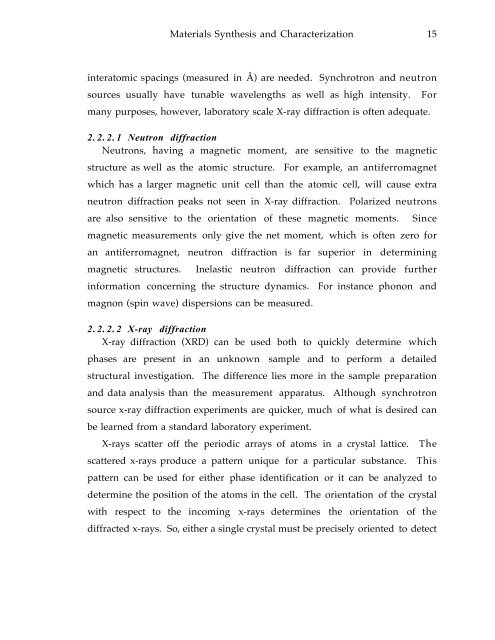MAGNETISM ELECTRON TRANSPORT MAGNETORESISTIVE LANTHANUM CALCIUM MANGANITE
MAGNETISM ELECTRON TRANSPORT MAGNETORESISTIVE LANTHANUM CALCIUM MANGANITE
MAGNETISM ELECTRON TRANSPORT MAGNETORESISTIVE LANTHANUM CALCIUM MANGANITE
Create successful ePaper yourself
Turn your PDF publications into a flip-book with our unique Google optimized e-Paper software.
Materials Synthesis and Characterization 15<br />
interatomic spacings (measured in ) are needed. Synchrotron and neutron<br />
sources usually have tunable wavelengths as well as high intensity. For<br />
many purposes, however, laboratory scale X-ray diffraction is often adequate.<br />
2. 2. 2. 1 Neutron diffraction<br />
Neutrons, having a magnetic moment, are sensitive to the magnetic<br />
structure as well as the atomic structure. For example, an antiferromagnet<br />
which has a larger magnetic unit cell than the atomic cell, will cause extra<br />
neutron diffraction peaks not seen in X-ray diffraction. Polarized neutrons<br />
are also sensitive to the orientation of these magnetic moments. Since<br />
magnetic measurements only give the net moment, which is often zero for<br />
an antiferromagnet, neutron diffraction is far superior in determining<br />
magnetic structures. Inelastic neutron diffraction can provide further<br />
information concerning the structure dynamics. For instance phonon and<br />
magnon (spin wave) dispersions can be measured.<br />
2.2.2.2 X-ray diffraction<br />
X-ray diffraction (XRD) can be used both to quickly determine which<br />
phases are present in an unknown sample and to perform a detailed<br />
structural investigation. The difference lies more in the sample preparation<br />
and data analysis than the measurement apparatus. Although synchrotron<br />
source x-ray diffraction experiments are quicker, much of what is desired can<br />
be learned from a standard laboratory experiment.<br />
X-rays scatter off the periodic arrays of atoms in a crystal lattice. The<br />
scattered x-rays produce a pattern unique for a particular substance. This<br />
pattern can be used for either phase identification or it can be analyzed to<br />
determine the position of the atoms in the cell. The orientation of the crystal<br />
with respect to the incoming x-rays determines the orientation of the<br />
diffracted x-rays. So, either a single crystal must be precisely oriented to detect
















